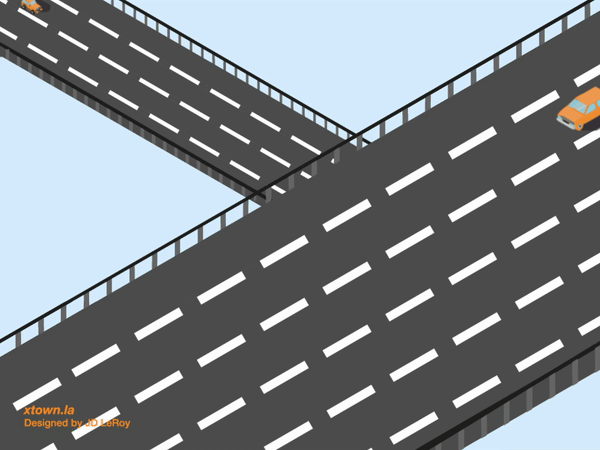The day the traffic died in Los Angeles

Monday, March 30: The day the immovable force of Los Angeles traffic did the impossible. It nearly disappeared.
On that day, traffic volumes in Downtown dropped 70% from the normal Monday levels. The number of cars driving in Santa Monica fell by 72%. In Hollywood, traffic levels were down 64%.
It was a situation city planners, public transportation advocates and environmentalists had always dreamed about: a Monday in Los Angeles with quiet streets and loads of parking. It took a pandemic to bring it about, and even then, it did not last long. Traffic is long considered one of the major urban ills of life in Los Angeles, with drivers spending on average 103 hours a year stuck in congestion, according to traffic data firm Inrix. But not lately.

Early signs of a slowdown
Traffic began slowing at the beginning of March, as concerns about the spread of COVID-19 began to ramp up. But March 30 appears to be the day that car volume reached its low point, a trend that continued that entire week.
Crosstown examined hourly vehicle volume data across all of Los Angeles, as well as several nearby cities. The data was compiled as part of the Archived Transportation Data Management System, or ADMS, by the Integrated Media Systems Center at the University of Southern California, or IMSC. IMSC is a partner in Crosstown.
For the comparison, we used vehicle-volume data on major arterial roadways, such as Wilshire and Ventura Boulevards, for a period of five months prior to the COVID-19 shelter in place order, as a representative of normal traffic volume. By comparing the number of vehicles during a specific hour of the week, 8-9 a.m. on Monday, for example, to a normal volume, it is possible to determine how much traffic levels have fallen on a particular day vs. what normal volumes would be.
Lately, traffic has begun to creep back up (though there have been a number of days that registered sizable dips). Rush-hour tie-ups are reappearing. But six weeks ago, that was not yet the case.
The #101Fwy SB looking good into Downtown @KNX1070 #KNXTraffic #LATraffic pic.twitter.com/h49cL74cfD
— scott burt (@scottburtknx) March 30, 2020
March comes to a halt
A number of forces aligned to turn March 30 into the day without traffic. Gov. Gavin Newsom had issued his stay-at-home order on March 19. But that first weekend, many Californians still had not gotten the memo, and they flocked to beaches and parks. Also, March 30 was Cesar Chavez Day. Normally, schools would be closed that day, but they were already closed due to COVID-19. County and city offices were already drained of all but essential workers. However, on that day, those workers who were not sent home had the day off.
This prompted a widespread scolding from officials on March 23, who promptly closed off hiking trails, beach access and many other outdoor spaces. Newsom also declared a “major disaster” in Southern California, in which he stated that the state was being “disproportionately impacted” by COVID-19.
Traffic had already been thinning out for some time at this point. A week earlier, March 16, registered the first sharp drop – that was the day bars, gyms, and movie theaters were ordered to shut down. It was also the day that the Los Angeles Unified School District closed the doors of its schools.

(Photo: Sara Kahn)
That day, Santa Monica traffic was down 43%. Westchester, which includes LAX, had traffic levels that were 37% lower than its typical volume.
But just two weeks later, on March 30, was when traffic levels appear to have hit their nadir.
A gradual shutdown
March 30 was the day LA farmers’ markets were suspended (though surrounding cities like Santa Monica’s and Torrance’s remained open), and the first coronavirus case was reported in LA’s homeless population.
Restaurants had already been on takeout and delivery-only since Los Angeles Mayor Eric Garcetti made it mandatory on Sunday, March 15. But some restaurants had already shut down since before then, such as Beverly Soon Tofu Restaurant in Koreatown, which only recently reopened for takeout and delivery.
Other facilities remained open until the very last possible moment, such as the 24-Hour-Fitness gym. It took to Twitter on March 16 to announce their mandatory closure, causing a wave of protest from dedicated gym rats.
“I’m pulling up tomorrow and if y’all don’t let me work out I’m changing to LA Fitness,” said Twitter user Bobby Hill.
“LA Fitness is closed until April 1st,” another Twitter user pointed out.
Little did they know the pandemic wouldn’t be over by April. Bobby Hill, maybe we’ll see you in July?
How we did it: We examined data from the ADMS Project traffic map to track traffic volumes for various neighborhoods. We compared current volume data in the months of March and April 2020 to each neighborhood’s typical traffic volume just five months prior. Learn more about our data here.
Want to know how your neighborhood fares? Or simply just interested in our data? Email us at askus@xtown.la.
*After initial publication, this article was updated with additional information.






